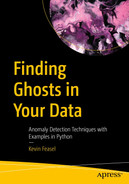Finding Ghosts in Your Data
Anomaly Detection Techniques with Examples in Python

The Apress logo.
This Apress imprint is published by the registered company APress Media, LLC, part of Springer Nature.
The registered company address is: 1 New York Plaza, New York, NY 10004, U.S.A.
To Mom and Dad, who know a thing or four about anomalies.
Welcome to this book on anomaly detection! Over the course of this book, we are going to build an anomaly detection engine in Python. In order to do that, we must first answer the question, “What is an anomaly?” Such a question has a simple answer, but in providing the simple answer, we open the door to more questions, whose answers open yet more doors. This is the joy and curse of the academic world: we can always go a little bit further down the rabbit hole.
Before we start diving into rabbit holes, however, let’s level-set expectations. All of the code in this book will be in Python. This is certainly not the only language you can use for the purpose—my esteemed technical reviewer, another colleague, and I wrote an anomaly detection engine using a combination of C# and R, so nothing requires that we use Python. We do cover language and other design choices in the book, so I’ll spare you the rest here. As far as your comfort level with Python goes, the purpose of this book is not to teach you the language, so I will assume some familiarity with the language. I do, of course, provide context to the code we will write and will spend extra time on concepts that are less intuitive. Furthermore, all of the code we will use in the book is available in an accompanying GitHub repository at https://github.com/Apress/finding-ghosts-in-your-data.
My goal in this book is not just to write an anomaly detection engine—it is to straddle the line between the academic and development worlds. There is a rich literature around anomaly detection, but much of the literature is dense and steeped with formal logic. I want to bring you some of the best insights from that academic literature but expose it in a way that makes sense for the large majority of developers. For this reason, each part in the book will have at least one chapter dedicated to theory. In addition, most of the code-writing chapters also start with the theory because it isn’t enough simply to type out a few commands or check a project’s readme for a sample method call; I want to help you understand why something is important, when an approach can work, and when the approach may fail. Furthermore, should you wish to take your own dive into the literature, the bibliography at the end of the book includes a variety of academic resources.
Before I sign off and we jump into the book, I want to give a special thank you to my colleague and technical editor, Ting Chou. I have the utmost respect for Ting’s skills, so much so that I tried to get her to coauthor the book with me! She did a lot to keep me on the right path and heavily influenced the final shape of this book, including certain choices of algorithms and parts of the tech stack that we will use. That said, any errors are, of course, mine and mine alone. Unfortunately.
If you have thoughts on the book or on anomaly detection, I’d love to hear from you. The easiest way to reach out is via email: [email protected]. In the meantime, I hope you enjoy the book.

A photograph of Kevin Feasel.

A photograph of Yin-Ting Chou.
